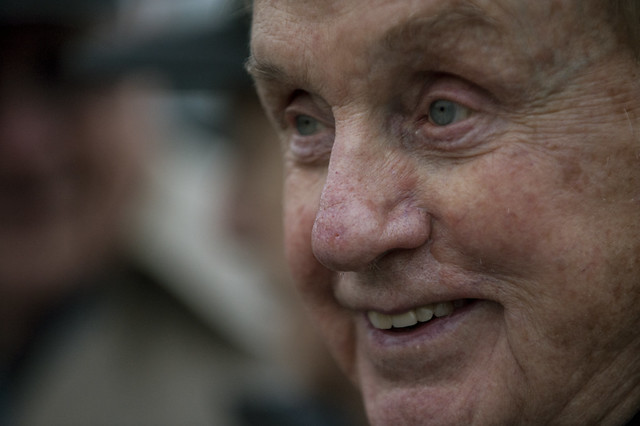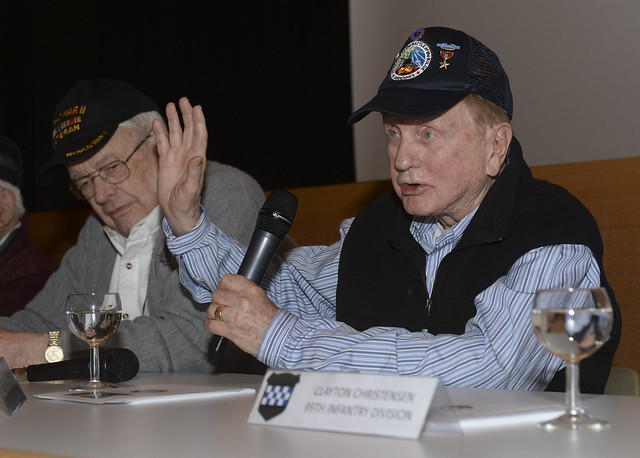SPANGDAHLEM AIR BASE, Germany -- EDITOR'S NOTE: This is the first installment of a 10-part series about asking the same five questions to 10 World War II veterans who served during the Battle of the Bulge Dec. 16, 1944, through Jan. 25, 1945. The veterans returned to Europe for 70th anniversary observances of the battle in Belgium and Luxembourg, Dec. 9-18, 2014.
J. David Bailey
106th Infantry Division, 422nd Infantry Regiment, 3rd Battalion, Company F

A native West Virginian drafted in November 1942, Bailey completed basic training at Camp Wheeler, Georgia., in April 1943 before qualifying for the Army Specialized Training Program. When ASTP was cancelled to provide replacements to depleted U.S. divisions and establish additional units for deployment, he was assigned to the newly formed Golden Lions of the 106th Infantry Division. Landing at Le Havre, Belgium, on Dec. 6th, 1944, his division was trucked straight to the front east of St. Vith, Belgium, relieving the 2nd Infantry Division in the Schnee Eifel sector - already inside Germany - "man for man, gun for gun" - Dec. 10 and 11.
Escaping the infamous German encirclement of the 422nd and 423rd Regiments at Schönberg, Belgium, he served in four campaigns and was awarded the Combat Infantry Badge, two Bronze Stars and other citations. Serving with occupation forces headquartered at Bad Ems, he returned stateside in November 1945 via Camp Lucky Strike. He returned to university after the war, becoming a professor and independent consultant to the mining and energy industries. Over the years, he's served as an advocate for the Disabled American Veterans, Veterans of the Battle of the Bulge president (2010-2012) and participated in numerous organizations focused on preserving the history of American service during World War II.
Where were you during the Battle of the Bulge?
I was drafted in the Army in November 1942. After basic training, I qualified for the U.S. Army Specialized Training Program and was sent to Alabama Polytechnic Institute for Military Government and to Clemson A&M for Engineering. The goal of the ASTP was that, once the war ended, the United States would have an available stratum of talent -- a pool of available leaders. However, ASTP eventually folded as the Army realized it needed replacements more desperately than it needed future leaders.
I was sent to the newly organized 106th Infantry Division and eventually assigned to Company F, 422nd Infantry Regiment. The 106th landed at Le Harvre, France, on December 6, 1944 and arrived at St. Vith, Belgium, on December 10.
The Division went on line the next day at the Schnee Eifel - a wooded, snow covered ridge of the Ardennes Forest covering a 27-mile front that bordered Germany and was just northeast of Luxembourg. The Army at this time used the Ardennes to acquaint newcomers, like the 106th, with some elements of infantry warfare -- such as observing and patrolling.
Needless to say and against all odds, in the early morning of December 16th, the Germans launched a surprise attack outnumbering our troops by a factor of five in terms of armor and manpower. Our Division had only five days of frontline experience, and tragically we had no air coverage due to the dense fog, and, indeed, we could not connect to our supply lines. The Division's 422nd and 423rd Regiments were encircled and cut off from the remainder of the Division by a junction of enemy forces in the vicinity of Schonberg. The regiments regrouped for a counterattack but were blocked by the enemy and separated from the 106th on December 18. The two regiments surrendered to the Germans on the following day.
So sudden and swift was the attack that it soon punctured a huge hole, or salient, in the Allied lines that gave the battle its name: the Bulge. This was the largest mass surrender of U.S. troops in Europe during World War II. Those of us who were able to escape eventually reached the forward and/or rear echelon of the 106th for reassignment.

How does it feel to be back 70 years later?
I have returned to Belgium and Luxembourg for the 50th, 60th, and 70th Commemorative years out of respect for those we left behind, that had no more tomorrows so that we could live in peace today. I will also be here for the 75th Commemorative in 2019.
What was the proudest moment of your military career?
My proudest moment in my military career was that the losses and sacrifices of the 106th Infantry paid great dividends in the eventual victory. The men of the 106th wear their insignia -- The Golden Lion -- with great pride and humility.
What got you through some of the toughest of times?
What got me through my toughest moments in my military career could be answered in three simple words -- "My Guardian Angel."

What advice do you have for the men and women in uniform today?
Believe in the best, think your best, have a goal for your best, try your best, and, in the long run, things will turn out for the best. And that indeed no man is worth his salt who is not ready at all times to risk his body, to risk his well-being, to risk his life to a great cause.
Remember! -- To accomplish what is important to us in life, we must not only act, but also to dream -- not only plan, but also believe.
EDITOR'S NOTE: Bailey's biography provided by the Veterans of the Battle of the Bulge.
Video by Senior Airman Rusty Frank.
Photos by Staff Sgt. Joe W. McFadden and Senior Airman Rusty Frank.